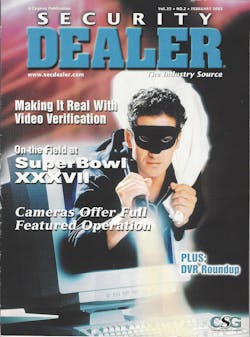As part of SD&I’s 40th anniversary celebration in 2018, I thought it would be interesting to use this column to take a few looks back at the technologies and news that made headlines in the past – so here’s a fast-rewind 15 years, all the way back to February 2003.
I bet you thought that video verification of alarms was relatively new…but it turns out the topic was cover-worthy way back then – cheesy artwork of a burglar coming out of what looks like a 20-year-old (at the time) IBM personal computer notwithstanding.
Back in 2003, video alarm verification was a novel, basically futuristic concept. The article cites a new proposal in Los Angeles that called for non-response of alarms without verification. This led to a new policy in 2004, where each alarmed location within the city was afforded two false alarm activations within a rolling year; however, after two false alarm activations, verification would be required in order to dispatch the call to a patrol unit.
In response to the proposal, then-NBFAA vice president George Gunning posited that it would “take at least a year before enough guards could be trained to meet the demand a law like this would require.” Gunning’s alternative was CCTV – only the industry had to figure out how to transmit surveillance images over POTS lines!
False alarms, it seems, will always be an Achilles’ heel for our industry; however, when you fast forward to today, as we know, video alarm verification has turned into a more ubiquitous feature – even for modern residential security systems. But even with IP technology that has made sending video surveillance images to monitoring centers simple, video verification is still a new add-on for all kinds of security systems.
ADT, for example, just introduced video alarm verification services specifically designed for small and medium-sized businesses through its ADT Pulse system in December. The alarm event and video footage are sent to both a monitoring center and to the user’s app. In the case of an actual event, dispatchers will contact the authorities and provide them with descriptions of the incident and individuals visible on the video helping to facilitate a prioritized response.
When it comes to today’s home security systems – where false alarms are so out of control that some municipalities are fining both the security company AND the home user for them – video verification is also taking a vastly increased role.
“For us to be able to provide the added benefit of visual information to a monitoring station so that the right information can be passed on to the authorities to help us catch a bad guy or deal with an emergency, we think that’s a true selling benefit for dealers and a differentiator today,” explains Gene LaNois, head of Nest’s Professional Channel. Last year, Nest became one of a group of companies to partner with video verification provider I-View Now.
Still, today – as it was 15 years ago – building awareness of the technological capabilities of video verification among end-users remains a challenge. “We really want to try to help create the awareness of how important video verification is,” LaNois adds in a testimonial on I-View Now’s website.
I-View Now is indeed spearheading that charge (as it should) – partnering with ADT, Nest, Honeywell, Eagle Eye, Bold Technologies and UTC, to name a handful.
When an editor pulls up this column in year 2033, I bet he or she will wonder with amazement how this industry ever got by without every single alarm – commercial, home or otherwise – being video-verified…even if the video is of a masked burglar and it is being sent to a dinosaur smartphone!
Paul Rothman is Editor in Chief of Security Dealer & Integrator (SD&I) magazine. Access the current issue, archives and subscription information at www.secdealer.com.




